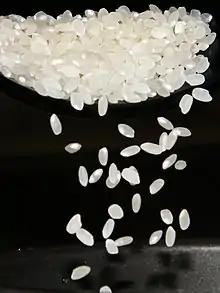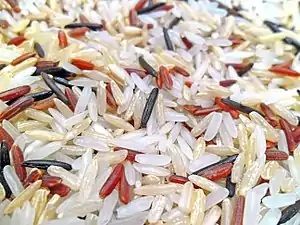Koshihikari
Koshihikari (Japanese: コシヒカリ, 越光, Hepburn: Koshihikari) is a popular cultivar of Japonica rice cultivated in Japan as well as Australia and the United States.
| Koshihikari | |
|---|---|
 | |
| Hybrid parentage | 'Nourin No.1' × 'Nourin No.22' |
| Subspecies | O. s. subsp. japonica |
| Cultivar group | temperate japonica |
| Cultivar | Nourin No.100 (Etsunan No.17) |
| Marketing names | Koshihikari |
| Origin | Japan, 1956 |
Koshihikari was first created in 1956 by combining 2 different strains of Nourin No.1 and Nourin No.22 at the Fukui Prefectural Agricultural Research Facility. It is one of the most highly grown varieties of rice in Japan [1] and is exported to other countries as a premium product.[2]
Etymology
The character for koshi (越) is used to represent the old Koshi Province, which stretched from present-day Fukui to Yamagata. Koshihikari can be translated as "the light of Koshi".
Related varieties
Other rice varieties close to its strains, such as Akitakomachi, Hitomebore, and Hinohikari were subsequently created by cross-breeding Koshihikari with other Japanese varieties of rice.
Characteristics
- Highly susceptible to blast disease
- Its stem collapses easily when mature
See also
References
- Ohtsubo, Ken'ichi; Okunishi, Tomoya; Suzuki, Koitaro (2005). "Processed novel foodstuffs from pregerminated brown rice". In Toriyama, K; Heong, KL; Hardy, B (eds.). Rice is Life: Scientific Perspectives for the 21st Century. International Rice Research Institute. ISBN 9789712202049.
- Kodachi, Hisao (2018-10-16). "Japan's China-bound rice exports set to soar". Nikkei Asian Review. Retrieved 2019-01-24.
External links
- JA Uonuma Minami (Japanese) JA branch in South of Uonuma area in Japan
